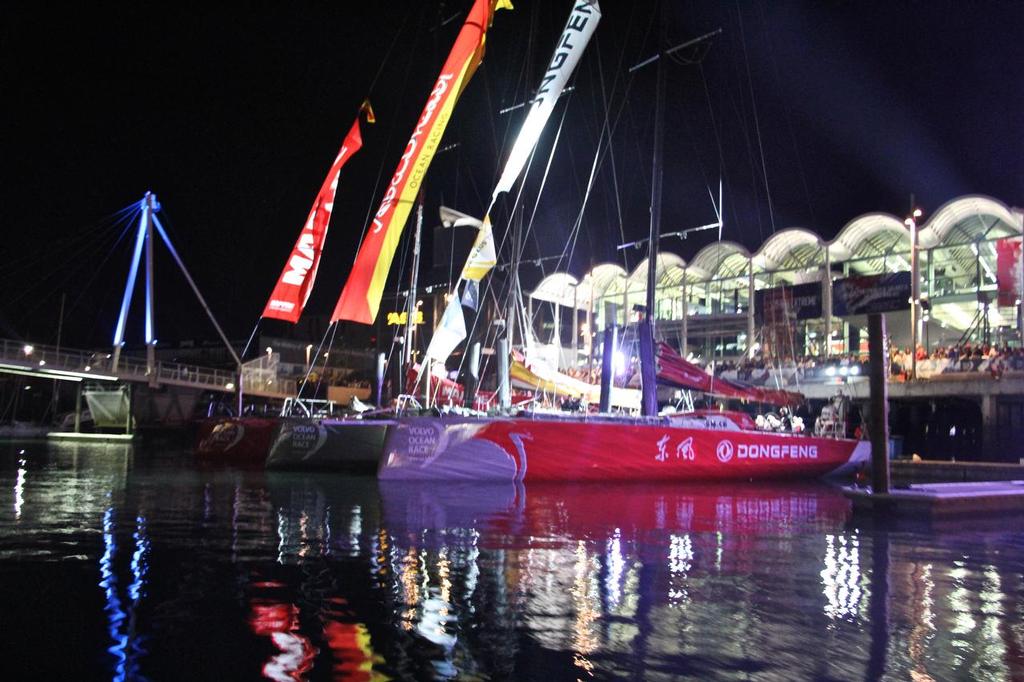Volvo Ocean Race – Vestas report and more time for analysis
by Rob Kothe & Jedda Murphy on 10 Mar 2015

First three finishers in the Viaduct - Leg 4, Finish - Volvo Ocean Race Richard Gladwell
www.photosport.co.nz
A pause in the racing and the opportunity to talk to the VOR skippers and crew in Auckland this week has provided a perfect opportunity for Richard Gladwell, our Sail-World New Zealand editor to bring out some major elements of this Round the World race.
An independent report into the grounding of Team Vestas Wind on Leg 2 of the Volvo Ocean Race was released today. It included a set of recommendations aimed at improving safety at sea for the entire offshore racing community.
In particular, it has suggested improving navigational charts and other on board software to avoid similar incidents in the future.
The Danish boat, Vestas Wind (Chris Nicholson/AUS), was stranded on a reef at Cargados Carajos Shoals in the middle of the Indian Ocean during the stage from Cape Town to Abu Dhabi on November 29. The crew were forced to abandon the boat.
The badly damaged Vestas Wind has since been retrieved from the reef and is being rebuilt in the Persico boatyard in Bergamo, Italy, with a view to returning to the race for the last two stages starting from Lisbon, Portugal in June, although a Lorient (France) return might now be more likely.
The independent report into the incident, commissioned by the Race in December, was conducted by acknowledged experts in the field – Rear Admiral (Rtd) Chris Oxenbould (chair), Stan Honey and Chuck Hawley.
The panel reported that the facts of the grounding had already been well publicised and that its findings regarding what happened are based on interviews with the crew, race management, other relevant parties and recorded data were not contentious.
'The team was unaware of any navigational danger in its vicinity, incorrectly assessed the minimum charted depth at Cargados Carajos Shoals to be 40 metres and understood that it was safe to sail across the shoals,' summed up the panel.
The panel has not apportioned blame, but made the following conclusions:
i. There were deficiencies in the use of electronic charts and other navigational data onboard Vestas Wind.
ii. There were also deficiencies in the cartography presenting the navigational dangers on the small and medium scales of the chart system in use.
iii. The emergency management worked well and there were no administrative or race management issues that contributed to the incident.
The 81 page report can be read online, see links in our report story.
We have more interviews and features coming up next week as we look forward to the In Port race on Saturday and Leg 5 start on Sunday - stay tuned to www.sail-world.com for all the latest news. we will also be following the latest forecast for the two days of racing next weekend.
Right now the start would appear to be in jeopardy with easterly winds gusting well over 40 kts predicted for the race start on Sunday and close to 30kts for the In Port race on Saturday.
The closeness of the VOR 65 One design racing was been underlined in leg from Sanya to Auckland. Now the role of the AIS in keeping the fleet together is very visible.
During Leg one into Cape Town Abu Dhabi Racing skipper Ian Walker during a sat phone conversation with Sail-World talked of the radical crew conversation about slowing their boat to fall off out of AIS range to allow them to separate from the fleet undetected. The conversation has continued into Auckland as Richard Gladwell reports.
The new Volvo Ocean Race is quite different from those which have gone before. One new element is the way the shore support is run, with the teams effectively booking their boats into a service facility to get a 20,000nm check instead of each carrying their own team of engineers - with duplication time six/seven.
Certainly the approach taken by the new Volvo Ocean Race makes a lot of sense and this week Sail-World features The Boatyard. We have a report and images, plus a video of the tour conducted by Shore Team Manager, Nick Bice.
The chemistry off the water between the teams seems to be very good, without the schisms that pervade other events, and used to be present in the Volvo OR and Whitbread Races. Maybe a bit of the needle has gone - but everyone knows that the real test with this race is boats, crews and individuals battling the Elements.
The closeness of the racing is also a feature of the new Volvo Ocean Race. We have discussed this with several of the crew and skippers since the race finish, and have a feature in this edition which explains the underlying issues. Again whether the race stays this way in the Southern Ocean remains to be seen.
Meanwhile the Barcelona World Race continues with most of the fleet now back in the Atlantic, the end of the race is almost in sight. Read on for the big global stories of the week.
If you want to link to this article then please use this URL: www.sail-world.com/132263